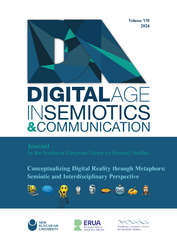Conceptualizing digital reality through metaphors in public service announcements: A semiotic perspective
Conceptualizing digital reality through metaphors in public service announcements: A semiotic perspective
Author(s): Nataliya LysaSubject(s): Politics / Political Sciences, Philosophy, Economy, Semiology, Governance, Public Administration, ICT Information and Communications Technologies
Published by: Нов български университет
Keywords: digital reality; digital metaphor; public service announcement; complex cultural sign; multimodality; representation
Summary/Abstract: This article discusses the conceptualization of digital reality through metaphors in public service announcements (PSAs), employing a semiotic perspective. PSA is viewed as a complex sign in the space of culture generated by social institutions to be shared with the general public and to raise awareness about important issues of society. The discussion is based on three basic claims: firstly, as digital reality increasingly spreads throughout modern life, digital technology shapes how we understand and experience the world and profoundly alters meanings and cognitive structures; secondly, the creation and reconfiguration of meanings and cognitive structures caused by digital artifacts occurs through metaphorization processes resulting in the creation of digital metaphors; thirdly, digital metaphors are the driving force behind creation and a way of producing original PSAs and display commitment to innovation reflected in the selection of signs. The article proposes a theoretical framework that integrates the concepts of “digital metaphor” and “representation” in Peircean view, thus creating a semiotic perspective of interpreting the “discoverability” i.e. public perception and comprehension of PSAs. Special attention is paid to the multimodal nature of the complex cultural signs under study and the representative characters of different representamens. The analysis of some PSAs containing digital metaphors is provided to substantiate the potential of the suggested theoretical framework. The article draws inspiration from works by Charles S. Peirce (1903), Umberto Eco (2014), Ibrus Indrek and Peeter Torop (2015), Kristian Bankov (2022), Eric Chown and Fernando Nascimento (2023), and others.
Journal: Digital Age in Semiotics & Communication
- Issue Year: VII/2025
- Issue No: 1
- Page Range: 139-152
- Page Count: 14
- Language: English

